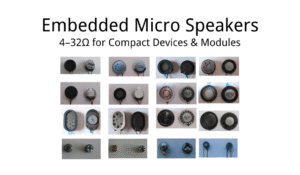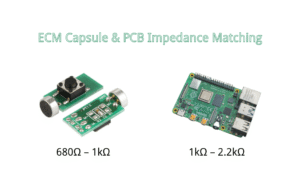Inhaltsverzeichnis

Ein Elektretmikrofon ist ein weit verbreitetes kleines Kondensatormikrofon, das in vielen elektronischen Geräten zu finden ist. Es enthält ein permanent geladenes Elektretmaterial, das ein elektrisches Feld zwischen den Kondensatorplatten aufrechterhält, ohne dass eine externe Polarisationsspannung erforderlich ist, was das Mikrofondesign und die Integration erheblich vereinfacht.
Das Elektretmikrofon ist für seine stabile Leistung und Kosteneffizienz bekannt und bleibt eine beliebte Wahl für Lavalier- und Kopfbügelmikrofone, Funksprechgeräte, Überwachungsgeräte und Messinstrumente.
Eine große Auswahl an hochwertigen Elektretmikrofonen finden Sie in unserem Elektretmikrofone Produktseite.
Elektretmikrofon vs. traditionelles Kondensatormikrofon
Sowohl Elektretmikrofone als auch herkömmliche Kondensatormikrofone arbeiten nach dem Prinzip der variablen Kapazität, die durch Membranschwingungen verursacht wird. Der entscheidende Unterschied liegt jedoch darin, wie der Kondensator gepolt ist:
- Traditionelle Kondensatormikrofone erfordern eine externe Hochspannungsversorgung (Phantomspeisung oder spezielle Vorspannung), um den Kondensator zu polarisieren.
- Elektret-Mikrofone verwenden ein permanent geladenes Elektretmaterial, das in die Membran oder die Rückplatte eingebettet ist, wodurch die Notwendigkeit einer externen Polarisationsspannung entfällt.
Dadurch sind Elektretmikrofone kleiner, kostengünstiger und lassen sich leichter in Verbrauchergeräte integrieren. In den letzten Jahren haben sich Elektret-Kondensatormikrofone erheblich weiterentwickelt und werden zunehmend in vielen professionellen Aufnahmesituationen eingesetzt, obwohl traditionelle Kondensatormikrofone für bestimmte High-End-Anwendungen weiterhin bevorzugt werden.
Brauchen Elektretmikrofone Strom?
Obwohl das Elektretmikrofon eine permanent polarisierte Schicht enthält, benötigt der eingebaute Feldeffekttransistor (FET)-Verstärker zum Betrieb eine Gleichstromvorspannung. Die typische Versorgungsspannung liegt zwischen 1,5 V und 4,5 V, in der Regel bei 2 V.

Verschiedene Modelle können unterschiedliche Spannungen erfordern. Eine zu hohe oder zu niedrige Spannung kann die Leistung und Lebensdauer des Mikrofons beeinträchtigen. Halten Sie sich daher unbedingt an die Angaben im Datenblatt.
Wie funktioniert ein Elektretmikrofon?
Elektretmikrofone arbeiten nach dem Kondensatorprinzip. Im Inneren des Mikrofons bilden die Membran und die Elektretelektrode einen Kondensator. Schallwellen versetzen die Membran in Schwingung, wodurch sich die Kapazität ändert. Der eingebaute FET-Verstärker wandelt diese Kapazitätsänderungen in elektrische Signale um.
Es gibt zwei Haupttypen von Elektretstrukturen: Front-Elektret und Back-Elektret. Bei der Front-Elektret-Konstruktion befindet sich das geladene Material auf der Membran selbst, während es beim Back-Elektret auf der Rückplatte hinter der Membran angeordnet ist.
Heutzutage verwenden die meisten Elektretmikrofone die Back-Elektret-Struktur, da sie im Vergleich zum älteren Front-Elektret-Typ eine höhere Stabilität, weniger Rauschen und einen besseren Frequenzgang bietet.
Da das Elektretmaterial permanent geladen ist, benötigt das Mikrofon keine externe Polarisationsspannung, was es von herkömmlichen Kondensatormikrofonen unterscheidet.
Wie benutzt und verkabelt man ein Elektretmikrofon?
Elektretmikrofone haben in der Regel zwei Leitungen: positiv (Strom) und negativ (Masse).
Die korrekte Verdrahtung ist entscheidend für den ordnungsgemäßen Betrieb des Mikrofons. Schließen Sie in der Regel das Pluskabel an die angegebene Versorgungsspannung (z. B. 2 V) und das Minuskabel an Masse an.
Es wird empfohlen, die im Datenblatt des Mikrofons angegebenen elektrischen Parameter und Verdrahtungspläne zu beachten, um eine Beschädigung des Bauteils zu vermeiden.
Wie kann man die Polarität von Elektretmikrofonen erkennen?

| Schritt | Methode | Positive Führung | Minusleitung | Anmerkungen |
|---|---|---|---|---|
| 1 | Visuelle Inspektion | Markiert mit "+" Symbol | Markiert mit "-" Symbol | Prüfen Sie zuerst die Symbole für höchste Genauigkeit |
| 2 | PCB-Pad beachten | Pad vollständig von grüner oder blauer Lötmaske umgeben | Pad direkt mit dem Metallgehäuse verbunden, keine Lötmaske | Verwenden Sie eine Lupe zur besseren Beurteilung |
| 3 | Multimeter-Messung | Widerstand zum Gehäuse zwischen 2,2kΩ und 10kΩ | Widerstand gegen Gehäuse weniger als 5Ω | 2kΩ Widerstandseinstellung am Multimeter verwenden |
| * | Datenblatt prüfen | Beschriftet als "+"-Klemme | Kennzeichnung als "-"-Klemme | Maßgeblichste Methode, anwendbar für alle Modelle |
Standardbetriebsspannung für Elektretmikrofone
Die typische Betriebsspannung für Elektretmikrofone reicht von 1,5 V bis 4,5 V. Übliche Spannungen sind 1,5 V, 2 V, 2,1 V, 2,2 V, 3 V und 4,5 V.
Die Versorgungsspannung hat einen großen Einfluss auf die Leistung des Mikrofons. Eine zu hohe Spannung kann zu Verzerrungen führen, während eine zu niedrige Spannung ein schwaches Signal, eine geringere Empfindlichkeit und einen schlechten Signal-Rausch-Abstand zur Folge hat.
Es wird empfohlen, die im Datenblatt des Mikrofons angegebenen Spannungswerte genau einzuhalten.
Geschichte: Wann wurde das Elektretmikrofon erfunden?
Das Elektretmikrofon wurde 1962 von James West und Gerhard Sessler in den Bell Labs erfunden. Seine einfache Struktur, die niedrigen Kosten und die stabile Leistung machten es schnell zur marktbeherrschenden Mikrofontechnologie.
Wie testet man ein Elektretmikrofon?
Bei der Prüfung eines Elektretmikrofons werden in der Regel Widerstand und Spannung mit einem Multimeter gemessen, um die korrekte Stromversorgung und das Ausgangssignal sicherzustellen.
Für genauere Tests verwenden Sie ein Oszilloskop und Audiotestgeräte, um die Signalqualität gemäß dem technischen Datenblatt des Mikrofons zu bewerten.
Abschluss
Elektretmikrofone sind wegen ihrer Kosteneffizienz und zuverlässigen Leistung weit verbreitet. Das Verständnis ihrer Funktionsprinzipien, der Polaritätskennzeichnung, der Leistungsanforderungen und der korrekten Verdrahtung ist für die Entwicklung und den effektiven Einsatz dieser Mikrofone entscheidend.


